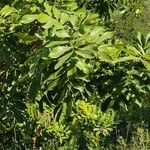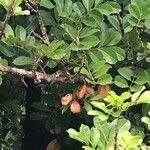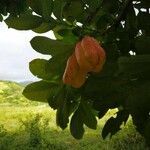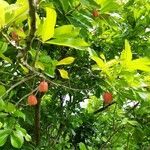Tree 10-20 m tall; stems ferruginous-tomentose, glabrescent. Leaves paripinnate or less often imparipinnate; petiole plus rachis 4-17 cm long, carinate, puberulent; leaflets 4-8 (5), opposite or nearly so, chartaceous or subcoriaceous, adaxially glabrous and lustrous, abaxially puberulent along midvein, elliptic to oblanceolate, 5-15(20) × 3-5.5(8) cm, the apex obtuse, rounded or short-acuminate, the base obtuse to subcuneate, slightly unequal, the margins entire. Inflorescence of axillary, simple or paniculate racemes, shorter than the subtending leaf, axes puberulent to tomentulose; bracts subulate, minute; flowers solitary or in depauperate dichasia. Sepals narrowly ovate, 2.5-3 mm long, green, tomentulose; petals ca. 4 mm long, white, lanceolate, tomentulose; appendage ca. 2 mm long; disc cupular, tomentose; stamens 8, ca. 6 mm long, filaments densely pubescent at base. Capsule trigonous-pyriform, 3(4)-locular, 6-8 cm long, shortly stipitate, pericarp woody, thick, outer surface glabrous, lustrous, red, the inner surface densely creamish lanose. Seeds ellipsoid, ca. 2.5 cm long, black, shiny, with an enlarged, fleshy, cream aril covering its lower third.
A small evergreen tree up to 9-13-20 m tall. It spreads to 3 m across. The stem is erect and branching. It has a spreading, open-textured crown. The leaves are dark green with 6, 8 or 10 curved leaflets. The flowers are greenish white in branched flowers stalks, in the axils of leaves. They extend upwards. The fruit are in clusters. The fruit is about 9 cm long and red when ripe. The fruit has five segments. It is roughly pear shaped. The fruit opens naturally when ripe and usually has 3 black seeds inside. These are covered with yellowish flesh called an aril. The aril is edible. The pink tissue is toxic. Unripe fruit are toxic.





